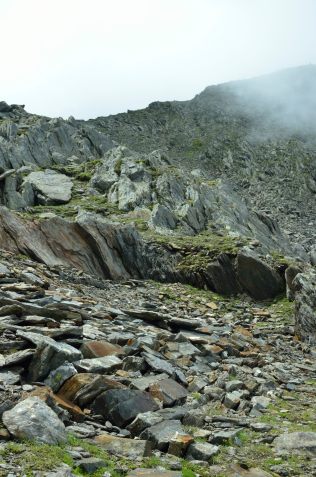Time to finally write a last “Traversar” post for this year. There are really two sides to our Passes of the Grison Project. Mostly we do inventory related work. We survey the study areas and record any archaeological sites we discover. There is of course a research element to this. The archaeology of many of the regions we study is not very well-known and anything we discover increases our knowledge of the (pre-)history of the region. We don’t excavate, though. We do make small test-trenches of up to ca. 30×30 cm or take auger cores at most sites we find. These allow us to evaluate the stratigraphy and if we are lucky we might find artefacts or, more likely, we can take charcoal samples for radiocarbon dating.

Recording probably 20th century military structures near the Passo Bornengo.
The sites we find become part of the cantonal database of archaeological sites. This again allows the archaeological service to react when sites become threatened by building plans, erosion, ploughing etc. Our work in the Oberalppass area is an example of this. You might not realise it, but mountain slopes get bulldozed quite properly these days before they become a ski-piste. Also, pylons for lifts, water pipes for artificial snow-installations, foundations for your favourite ski bar and artificial lakes to hold water for making artificial snow, they all need substantial holes in the ground. A major expansion of the Andermatt-Sedrun Ski Arena is planned. And the Disentis 3000 ski area plans to install a whole system of snow blowers to guarantee its guests a good snow cover. Such plans will become ever more common with increasing winter temperatures and should get appropriate archaeological attention throughout the Alps.

Passo Bornengo. Probable military structures; terracing & building remains (20th C).
So on Wednesday, we surveyed the relevant parts of the Disentis 3000 ski resort. Rudolf Büchi kindly took the time to explain the current plans and let us use the ski lifts to save time. Up in the ski area we were surprised to find quite a few hitherto unknown archaeological sites as well as further archaeologically interesting areas. It will be very very interesting to have a more detailed look at the finds we made and see the dates we get from the charcoal samples we took. Other areas, however, have already been heavily disturbed by previous building activities.
The days after this we were lucky the weather got a bit better. We turned our attention to the upper part of the Val Maighels and the Val Strem. In both valleys we recorded a number of building remains, which may relate to transhumance activity of Medieval or post-Medieval date. One of these, near the Chrüzlipass in the Val Strem, might well be much older. Very exciting. Hunter-gatherers and shepherds remained rather elusive, as so often. However, both on the Passo Bornengo and the Chrüzlipass we were surprised to find substantial building remains. These are almost certainly military, probably part of the fortifications made during the WWI. Later 20th century military structures are often well recorded, but few records exist of these WWI fortifications. Although Switzerland was neutral during WWI, mobilisation did take place and many passes were fortified. The canton of Graubünden/Grison has started to record some of these, hopefully other cantons with strategic passes will follow this example soon.

Val Maighels, near Passo Bornengo.
The finds we made in these two valley reflect the situation we found the rest of the week as well. Despite the not ideal weather, we have been able to do almost everything we wanted. Also, our expectations based on our desk-based work have been fulfilled. So also methodologically, we seem to be on the right track. Concerning those elusive hunter-gatherers, perhaps they did not leave many traces, perhaps these can only be found with more intensive surveying and more test-trenching.


